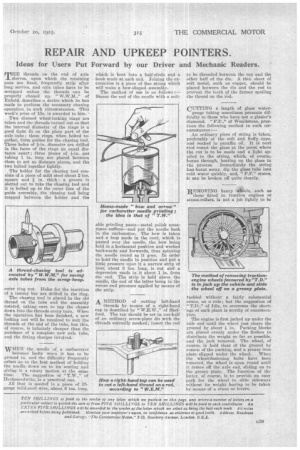REPAIR AND UPKEEP POINTERS.
Page 51

If you've noticed an error in this article please click here to report it so we can fix it.
Ideas for Users Put Forward by our Driver and Mechanic Readers.
THE threads on the end of axle sleeves, upon which the retaining nuts are fixed, frequently strip after long service, and axle tubes have to be scrapped unless the threads can be
properly chased up. " of Enfield, describes a device which he has made to perform the necessary chasing operation in such circumstances. This week's prize of ris. is awarded to him.'~
Two disused wheel-locking rings are taken and the threads turned out so that the internal diameter of the rings is a good tight Et on the plain part of the axle tube; these rings, when bolted together, form guides for the chasing tool. Three holes of -I-in. diameter are drilled in the faces of the rings an equal distance apart; three pieces of +-in. gas tubing 1 in. long are placed between them to act as distance pieces, and the two belted together tightly.
The holder for the chasing tool consists of a piece of mild steel about 2 ins. square and a in. thick ; a groove is slotted out to take the chasing tool and it is bolted up to the outer face of the guide assembly, the chasing tool being trapped between the holder and the
outer ring nut. Holes for the insertion of a tommy bar are drilled in the ring. The chasing tool is placed in the old thread on the tube and the assembly rotated, taking care to tap the chaser down into the threads every turn. When the operation has been finished, a new locking nut will be required to suit the threads at the end of the tube, but this, of course, is infinitely cheaper than the purchase of a complete new axle tube, and the fitting charges involved.
WHEN the needle of a carburetter becomes badly worn it has to be greund in, and the difficulty frequently arises as to the best method of bedding the needle down on to its seating and giving it a rotary motion at the same time. The. sug,geetion of "T.W.," of Heekmondwike, is a practical one. All that is needed is a piece of gauge mild-steel wire, about :8 ins, long,
which is bent into a half-circle and a hook made at each encl. Joining the extremities is a piece of fine string which will make a bow-shaped •assembly.
The method of use ie as follows:— Smear the end of the needle with a suit able grinding paste—metal polish sometimes suffices—and put the needle back in the carburetter. The bow is taken and a loop made in the cord, which is passed over the needle, the bow being held in a horizontal position and worked backwards and forwards, thus cminning the needle round as it goes. In order to hold the needle in position and put a little pressure upon it a narrow strip of iron about 3 ins. long, is cut and a depression made in it about 1 in. from the end. The strip is held above. the needle, the end of the latter being in the recess and pressure applied by means of
the strip. •
A METHOD of cutting left-hand
threads by moans of a right-hand tap is described by " W.E.W„" of Shefford. The tap should beget in one-half of an ordinary serew-plate die with the threads correctly meshed; insert the ro I to be threaded between the tap and the other half of the die. A thin sheet of soft metal, such as copper, should be placed between the die and the rod to prevent the teeth of the former spoiling the thread on the rod.
CUTTING a length of glass water gauge tubing sometimes presents difficulty to those who have not a glazier's diamond. " F.F.," of Wealcistone, practises the following method in such circumstances:— Au ordinary piece of string is taken, preferably of the soft and fluffy ;type, and soaked in paraffin oil. It is next tied round; the glass at the point where the cut is te be made and a light apPlied to the string, which, of course, burns through, heating up the glass in the process. Immediately the string has burnt away, dip the glass tube into cold water quickly, and, " F.F.." states, it can be broken off quite cleanly.
REMOVING heavy Wteels; such as those fitted to traction engines or steam-rollers, is not a job lightly to be tackled without a fairly substantial crane, as a rule ; but the suggestion of "T.D.," of Idle, to overcome the short' age of such plant is worthy of consideration.
The engine is first jacked up under the axle end until the -wheel just clears the ground by about + in. racking blocks are placed evenly under the firebox to distribute the weight so far as possible, and the jack removed. The wheel, of course, is held clear of the ground by reason of the packing, and a greasy iron plate slipped under the wheel. When the wheel-fastening bolts have been removed, the wheel is spun round until it comes off the axle end, sliding on to the greasy plate. The function of the latter, of course, is to provide an easy path for the wheel to slide sideways without its weight having to be taken by means of a crane or levers.




















































